Advertisements
Advertisements
Question
Prove that the diagonals of a parallelogram divide it into four triangles of equal area.
Solution

The diagonals of a parallelogram bisect each other.
Therefore, O is the mid-point of AC and BD.
Bo is the median in ΔABC.
Therefore, it will divide it into two triangles of equal areas
∴ ar(ΔAOB) = ar(ΔBOC)......(i)
In ΔBCD, CO is the median.
∴ ar(ΔBOC) = ar(ΔCOD).......(ii)
Similarly, ar(ΔCOD) = ar(ΔAOD)......(iii)
From (i), (ii) and (iii)
ar(ΔAOB) = ar(ΔBOC) = ar(ΔCOD) = ar(ΔAOD)
Hence, diagonals of a parallelogram divide it into foor triangles of equal areas.
APPEARS IN
RELATED QUESTIONS
In a parallelogram PQRS, M and N are the midpoints of the opposite sides PQ and RS respectively. Prove that
PMRN is a parallelogram.
In a parallelogram PQRS, M and N are the midpoints of the opposite sides PQ and RS respectively. Prove that
MN bisects QS.
ABCD is a trapezium in which side AB is parallel to side DC. P is the mid-point of side AD. IF Q is a point on the Side BC such that the segment PQ is parallel to DC, prove that PQ = `(1)/(2)("AB" + "DC")`.
In the given figure, PQRS is a parallelogram in which PA = AB = Prove that: SAQB is a parallelogram.
Prove that the diagonals of a kite intersect each other at right angles.
The diagonals AC and BC of a quadrilateral ABCD intersect at O. Prove that if BO = OD, then areas of ΔABC an ΔADC area equal.
In the given figure, AB ∥ SQ ∥ DC and AD ∥ PR ∥ BC. If the area of quadrilateral ABCD is 24 square units, find the area of quadrilateral PQRS.
In ΔABC, the mid-points of AB, BC and AC are P, Q and R respectively. Prove that BQRP is a parallelogram and that its area is half of ΔABC.
In ΔPQR, PS is a median. T is the mid-point of SR and M is the mid-point of PT. Prove that: ΔPMR = `(1)/(8)Δ"PQR"`.
In the figure, ABCD is a parallelogram and CP is parallel to DB. Prove that: Area of OBPC = `(3)/(4)"area of ABCD"`
